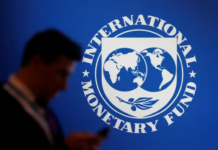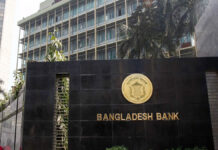Back in March, when the country was gripped by the fear of the novel coronavirus, people were streaming to banks to take out money from their accounts, in what was viewed as a puzzling occurrence.
Cashless payment was encouraged then to limit the risk of catching the highly contagious virus. Still, people were withdrawing cash but not necessarily spending more of it.
The breathtaking spike in cash withdrawals left bankers restive: how they would run their banks in the days to come if the depositors continued to take out funds at this rate.
This fix was not unique to Bangladesh; banks from all over the world were in the same boat.

Many countries are yet to get relief from the onslaught as currency held outside of banks in the US is still shooting up. In June, currency outside of banks in the US was 13 per cent higher than the same time one year earlier, and up 8 per cent from February.
But banks in Bangladesh have started to get respite from the tremendous withdrawal pressure as people are now depositing their money once again, overcoming their fear of coronavirus.
For instance, currency outside of banks in Bangladesh stood at Tk 192,384 crore in June, up from 19 per cent from February. But the figure in June declined nearly 1 per cent from May.
This indicates that deposits in banks are on the rise.
Deposits in the banking sector registered a growth of 2.07 per cent in June from May when the growth stood at 0.83 per cent. June’s growth is the highest in the last fiscal year.
In March, bank deposits recorded negative growth of 0.65 per cent in March, which slightly increased in April and May. The outstanding deposit of the commoners excluding the government and inter-bank stood at Tk 11,810,251 crore as of June, according to data from the central bank.
Both the upward trend of remittance and the injection of reserve money or high-powered money by the central bank for the implementation of the stimulus packages have helped banks in getting funds from people.
“This means the economy has started to blast off from the financial fallout,” said Ahsan H Mansur, executive director of the Policy Research Institute of Bangladesh.
Expatriate Bangladeshis sent home $1.83 billion in June, the highest in a single month, eclipsing the record $1.74 billion that flowed in May last year. In most of the cases, the recipients of the remittance keep a good amount of money at banks after completing their monthly expenses.
Besides, the government’s borrowing increased 109 per cent year-on-year to Tk 72,246 crore in fiscal 2019-20, which is an all-time high for a single year.
A large amount of the fund borrowed by the government has been deposited at banks, which is also responsible for the deposit growth.
The government has already taken an expansionary monetary stance since March in tackling the economic meltdown, boosting the deposit in the overall banking sector.
The growth of reserve money, which creates fresh currency in the financial sector, stood at 15.56 per cent in June against the growth of 5.32 per cent a year earlier.
Both the central bank and the government has already announced several stimulus packages of more than Tk 103,117 crore, which amounts to nearly 3.7 per cent of the country’s gross domestic product, to cushion the possible economic shock stemming from the pandemic.
Of the amount, the central bank has started providing a large portion of the fund from its own sources. This has given a boost to the deposit growth in banks as well.
“Money multiplier in the financial sector is still weak due to the ongoing economic fallout. But, this will get a gravity in the days ahead to keep up with the financial recovery,” said Mansur, also a former high official of the International Monetary Fund.
The money multiplier describes how an initial deposit leads to a greater final increase in the total money supply.
It represents the largest degree to which the money supply is influenced by changes in the quantity of deposits.
The central bank should cautiously monitor the banking sector such that the additional fund could be prevented from investing in the speculative sectors, Mansur said.
People who withdrew money in March and April have deposited their funds back to banks, helping lenders to enjoy adequate liquidity, said MA Halim Chowdhury, managing director of Pubali Bank.
Emranul Huq, managing director of Dhaka Bank, also mentioned an economic bounce from the downturn. But it is happening at a slower pace.
Businesses typically export products worth Tk 1,100 crore per month on average through Dhaka Bank, but the figure had gone down to Tk 256 crore in April.
But exports gradually increased to Tk 700 crore last month and the amount may be nearly Tk 1,000 crore in July.
“The exporters, on the whole, deposit the money in banks. But, we are facing a problem in disbursing credit as borrowers are reluctant to take loans,” Huq said.
Nearly 80 per cent of banks’ earnings traditionally come from the interest from lending. He, however, said lending is gradually increasing.
Banks hardly give out loans to the small- and medium-sized enterprises and retail sectors as the central bank has imposed an interest rate cap of 9 per cent since April, said another MD of a bank wishing not to be named.
The 9 per cent interest rate is not profitable for the SME and retail loans due to their high operational cost.
The economy will not get its full-fledged tempo if the central bank continues to force banks to maintain the cap for the two sectors, he said.










